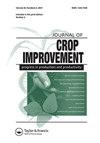Abscisic, gibberellic, and salicylic acids effects on germination indices of corn under salinity and drought stresses
IF 1.5
Q3 AGRONOMY
引用次数: 7
Abstract
ABSTRACT The expression of genes that control germination-related processes in corn (Zea mays L.) is influenced by environmental factors. Germination of seeds may be facilitated by hormonal priming. The purpose of this investigation was to quantify the effects of different germination temperatures [(5, 10, 15, 20, 25, 30, 35, and 40°C), NaCl-induced stress (0, −0.4, −0.8, and −1.2 MPa), and priming solutions (control, hydropriming, abscisic acid (ABA), gibberellic acid (GA), and salicylic acid (SA)] (Experiment 1). Effects of germination temperatures, PEG 6000-induced stress (0, −0.4, −0.8, and −1.2 MPa), and priming solutions were also evaluated separately (Experiment 2). In both cases, a completely randomized design with four replications was used. Increasing temperatures from 5 to 25°C gradually improved germination percentage and rate, whereas temperatures > 25°C decreased these indices. After imposing drought (PEG 6000-induced stress) or salinity (NaCl-induced stress) treatments, hormonal priming caused germination to occur at a lower base temperature, compared with the non-priming treatment. However, the effect of hormonal priming was dependent on temperature. At sub-optimal temperatures (< 25°C), the highest germination percentage and rate were recorded after GA priming. At above-optimal temperatures (> 25°C), ABA priming resulted in the highest germination percentage and rate. Moreover, hydrothermal time constant decreased in hormone-treated seeds. Based on coefficient of determination (R2 ) and root mean square error (RMSE), a dent-like model predicted cardinal temperatures more accurately than a beta model did. Generally, GA-, SA-, and ABA-priming were recommended under sub-optimal, optimal, and above-optimal temperatures, respectively.脱落酸、赤霉酸和水杨酸对盐度和干旱胁迫下玉米发芽指数的影响
玉米发芽相关基因的表达受环境因素的影响。激素引发可能促进种子发芽。本研究的目的是量化不同发芽温度[(5、10、15、20、25、30、35和40°C)、NaCl诱导的胁迫(0、−0.4、−0.8和−1.2 MPa)和引发溶液(对照、水培、脱落酸(ABA)、赤霉酸(GA)和水杨酸(SA))]的影响(实验1)。还分别评估了发芽温度、PEG 6000诱导的胁迫(0、−0.4、−0.8和−1.2 MPa)和引发溶液的影响(实验2)。在这两种情况下,均采用了四次重复的完全随机设计。将温度从5°C提高到25°C逐渐提高发芽率和发芽率,而>25°C的温度降低了这些指标。在施加干旱(PEG-6000诱导的胁迫)或盐度(NaCl诱导的应激)处理后,与非引发处理相比,激素引发导致发芽在较低的基础温度下发生。然而,激素引发的效果取决于温度。在次优温度(<25°C)下,GA引发后的发芽率和发芽率最高。在上述最适温度(>25°C)下,ABA引发的发芽率和发芽率最高。此外,在激素处理的种子中,水热时间常数降低。基于决定系数(R2)和均方根误差(RMSE),类凹痕模型比β模型更准确地预测基本温度。一般情况下,GA、SA和ABA分别在次优、最优和超优温度下引发。
本文章由计算机程序翻译,如有差异,请以英文原文为准。
求助全文
约1分钟内获得全文
求助全文
来源期刊

Journal of Crop Improvement
Multiple-
CiteScore
3.30
自引率
7.70%
发文量
42
期刊介绍:
Journal of Crop Science and Biotechnology (JCSB) is a peer-reviewed international journal published four times a year. JCSB publishes novel and advanced original research articles on topics related to the production science of field crops and resource plants, including cropping systems, sustainable agriculture, environmental change, post-harvest management, biodiversity, crop improvement, and recent advances in physiology and molecular biology. Also covered are related subjects in a wide range of sciences such as the ecological and physiological aspects of crop production and genetic, breeding, and biotechnological approaches for crop improvement.
 求助内容:
求助内容: 应助结果提醒方式:
应助结果提醒方式:


